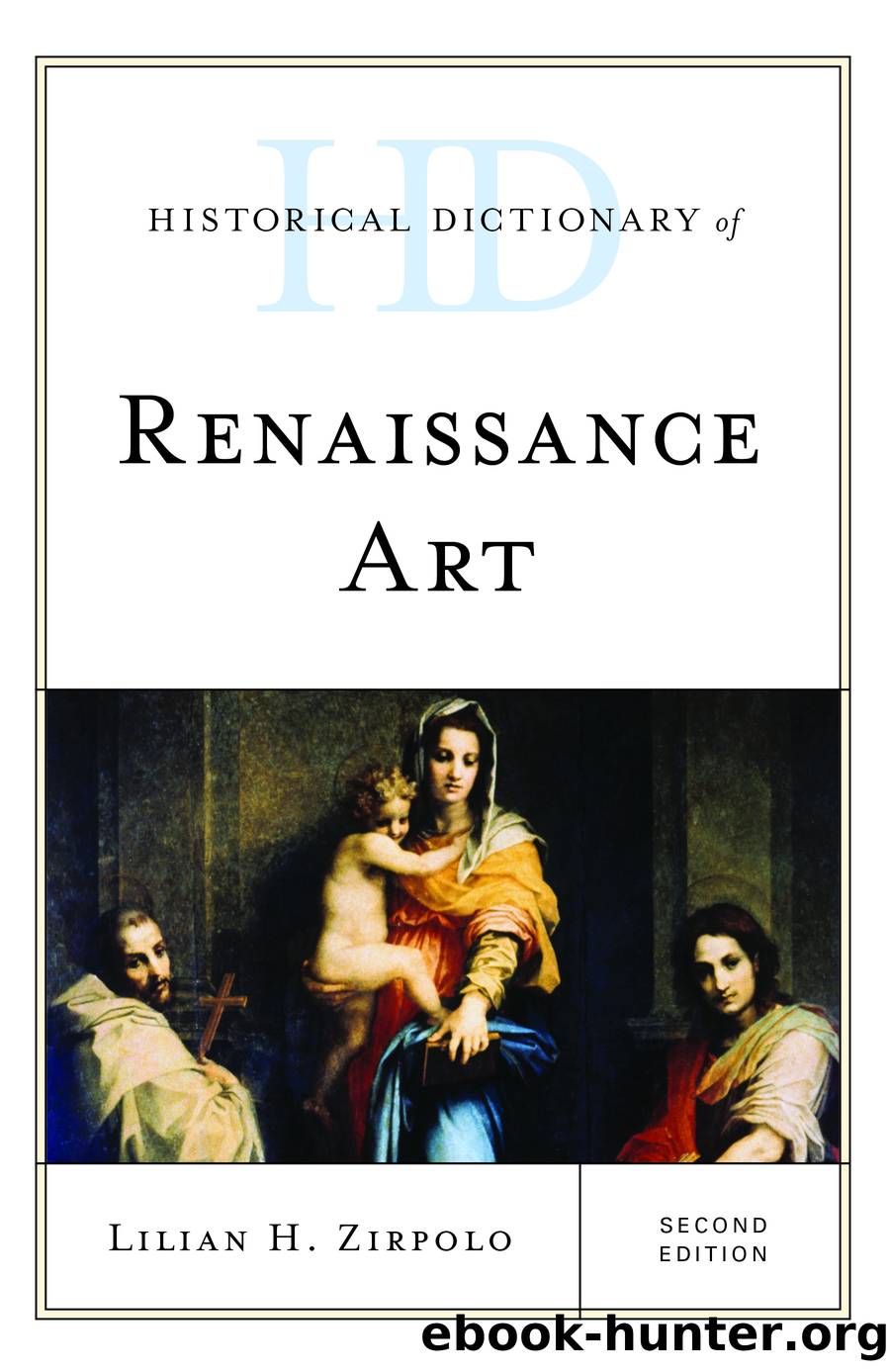Historical Dictionary of Renaissance Art by Lilian H. Zirpolo

Author:Lilian H. Zirpolo
Language: eng
Format: epub
Tags: undefined
Publisher: Rowman & Littlefield Publishers
Published: 2012-06-15T00:00:00+00:00
MANTEGNA, ANDREA (c. 1431–1506)
The leading painter of the Early Renaissance in Northern Italy; a master of perspective and foreshortening. Mantegna was born near Padua, where he was trained by painter Francesco Squarcione, who was also an art collector and dealer. From Squarcione Mantegna developed a keen interest in antiquity and learned to read Latin. His interest in the ancient world peaked when he became a member of a group in Verona that engaged in archaeological studies and often took boat rides on Lake Garda to read the classics. In 1453, Mantegna married Nicolosia, the daughter of Jacopo Bellini, becoming a member of the Bellini dynasty of painters.
His earliest commission is the Ovetari Chapel in the Church of the Ere- mitani in Padua (1454–1457). The contract for the work had to be signed by his brother, as Mantegna was considered too young to do so himself. The patron was Imperatrice Capodilista, wife of Antonio di Biagio degli Ovetari, who left funds in his will for the project. The scenes chosen were from the life of St. James. Unfortunately, these were lost to allied bombing during World War II and are only known through the few remaining fragments and photographs taken before their destruction. The photos reveal Mantegna’s understanding of the Florentine vocabulary and technical advancements in perspective. They also disclose the influence of Donatello, as Mantegna’s figures are as solid as the sculptor’s. In Mantegna’s St. James Led to his Execution, part of the Ovetari frescoed program, one of the soldiers is, in fact, based on Donatello’s St. George from Orsanmichele, Florence (1415–1417).
From 1456 to 1459, Mantegna painted the San Zeno Altarpiece for the Church of San Zeno in Verona. Here the elaborate architectural framework, created in a classical vocabulary, interacts with the painted image in that its columns are made to match precisely the painted piers in the foreground. Mantegna carried the classical idiom into the image itself by placing the enthroned Virgin and Child, musical angels, and saints in a chamber with piers that support a continuous all’antica frieze with garlands and putti. Here again, Donatello’s influence is noted in the overall composition. The architectural and figural arrangements depend on Donatello’s altar in the Church of San Antonio (il Santo) in Padua.
Mantegna’s Agony in the Garden (mid-1450s; London, National Gallery) is based on one of the drawings Jacopo Bellini created for teaching purposes. The work reveals Mantegna’s mastery at rendering foreshortened figures, specifically the sleeping Apostles in the foreground. In the middle ground, Judas leads the Romans to Christ, and in the background, the city of Jerusalem is shown as an ancient Roman city. To this period also belongs Mantegna’s St. Sebastian (1457–1458; Vienna, Kunsthistorisches Museum), which shows the saint amid Roman ruins. A foot fragment from an ancient statue is juxtaposed to the saint’s foot to denote that Mantegna learned well his lessons from the ancient masters.
In 1459, Mantegna moved to Mantua, where he became court painter to Duke Ludovico Gonzaga. There he remained until his death, painting altarpieces and frescoes, and designing pageants.
Download
This site does not store any files on its server. We only index and link to content provided by other sites. Please contact the content providers to delete copyright contents if any and email us, we'll remove relevant links or contents immediately.
The Secret History by Donna Tartt(16611)
Red Sparrow by Jason Matthews(4655)
Harry Potter 02 & The Chamber Of Secrets (Illustrated) by J.K. Rowling(3289)
In a Sunburned Country by Bill Bryson(2941)
Figure Drawing for Artists by Steve Huston(2792)
The Daily Stoic by Holiday Ryan & Hanselman Stephen(2703)
Drawing Cutting Edge Anatomy by Christopher Hart(2672)
The Roots of Romanticism (Second Edition) by Berlin Isaiah Hardy Henry Gray John(2565)
Japanese Design by Patricia J. Graham(2552)
Make Comics Like the Pros by Greg Pak(2421)
Stacked Decks by The Rotenberg Collection(2267)
Harry Potter and the Deathly Hallows (7) by J.K. Rowling(2213)
On Photography by Susan Sontag(2128)
Draw-A-Saurus by James Silvani(2102)
Tattoo Art by Doralba Picerno(2080)
Foreign Devils on the Silk Road: The Search for the Lost Treasures of Central Asia by Peter Hopkirk(2053)
The Traveler's Gift by Andy Andrews(2008)
Churchill by Paul Johnson(2006)
Drawing and Painting Birds by Tim Wootton(1997)
